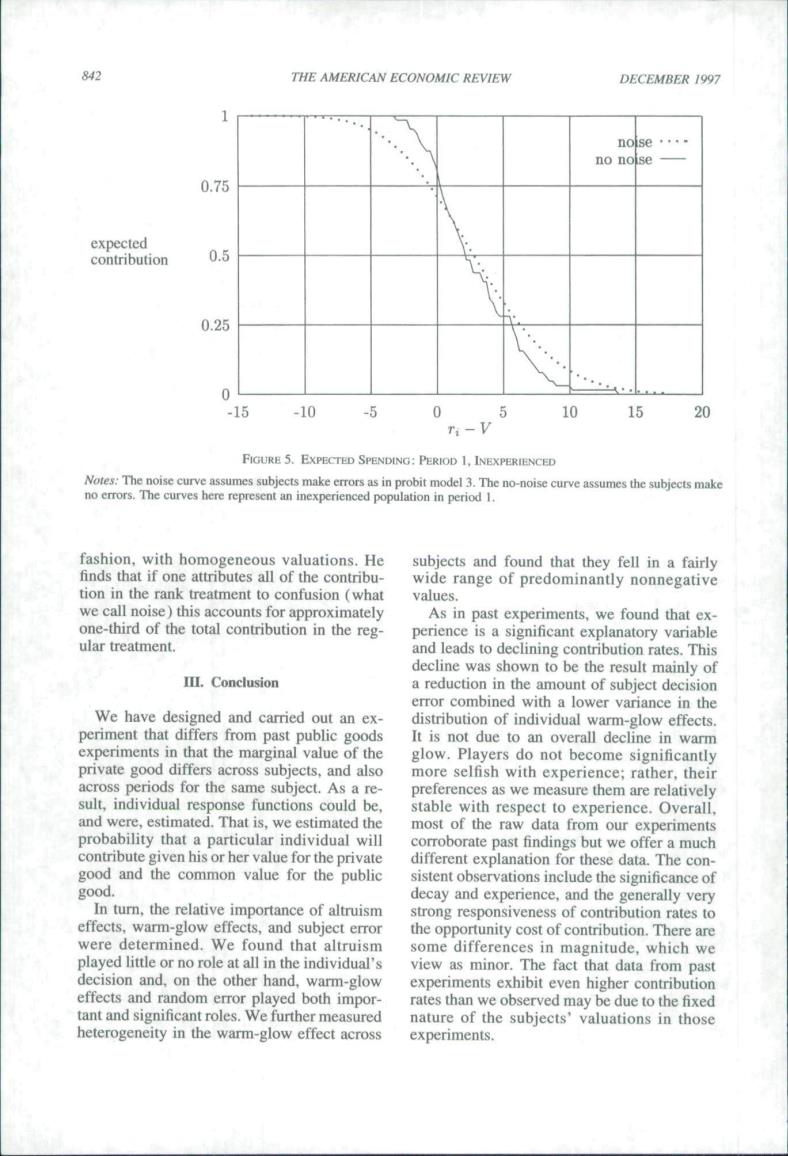正在加载图片...

THE AMERICAN ECONOMIC REVIEW DECEMBER 1997 no noise 0.75 expected contribution 05 0.25 0 -15 -10 -5 0 10 15 0 FIGURE 5.EXPECTED SPENDING:PERIOD 1.INEXPERIENCED tion in the rank treatment to confusion (what values As in past perments.we found that ular treatment. and leads to declini decline was shown to be the result mainly of III.Conclusion a reduction in the amount of subject decision It is not due to an ove experiments in that the marginal value of the glow.Players do not become significantly more selfish with experience;rather,their sult.individual res sure them are relauvely most of the raw data from oure ty that corroborate past findings but we offer a much good. decay and expe In tumn,the relative importance of altruism strong responsiveness of contribution rates to a the opportunity cost of contribution.There are played litte or no some which we decision and,on the other hand,warm-glow br pas rates than we observed may be due to the fixed er measured warm-glow effec nature of the subjects'valuations in those across expenments.842 THE AMERICAN ECONOMIC REVIEW DECEMBER 1997 0.75 expected contribution 0.25 \ no no no se se -15 -10 -5 10 15 20 FIGURE 5. EXPECTED SPENDING: 1, INEXPERIENCED Notes: TTie noise ctirve assumes subjects make errors as in probit model 3, The no-noise curve assumes the subjects make no errors, TTie curves here represent an inexperienced population in period 1. fashion, with homogeneous valuations. He finds that if one attributes all of the contribution in the rank treatment to confusion (what we call noise) this accounts for approximately one-third of the total contribution in the regular treatment. I in. Concltision We have designed and carried out an experiment that differs from past public goods experiments in that the marginal value of the private good differs across subjects, and also across periods for the same subject. As a result, individual response functions could be, and were, estimated. That is, we estimated the probability that a particular individual will contribute given his or her value for the private good and the common value for the public good. In tum, the relative importance of altruism effects, warm-glow effects, and subject error were determined. We found that altruism played little or no role at all in the individual's decision and. on the other hand, warm-glow effects and random error played both important and significant roles. We further measured heterogeneity in the warm-glow effect across subjects and found that they fell in a fairly wide range of predominantly nonnegative values. As in past experiments, we found that experience is a significant explanatory variable and leads to declining contribution rates. This decline was shown to be the result mainly of a reduction in the amount of subject decision error combined with a lower variance in the distribution of individual warm-glow effects. It is not due to an overall decline in warm glow. Players do not become significantly more selfish with experience; rather, their preferences as we measure them are relatively stable with respect to experience. Overall, most of the raw data from our experiments corroborate past findings but we offer a much different explanation for these data. The consistent observations include the significance of decay and experience, and the generally very strong responsiveness of contribution rates to the opportunity cost of contribution. There are some differences in magnitude, which we view as minor. The fact that data from past experiments exhibit even higher contribution rates than we observed may be due to the fixed nature of the subjects' valuations in those experiments